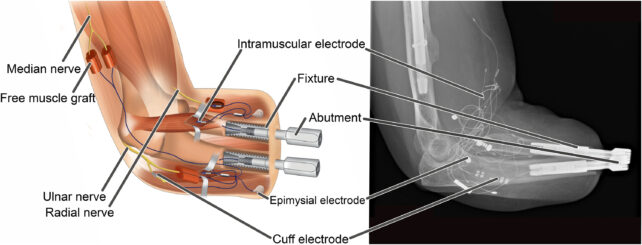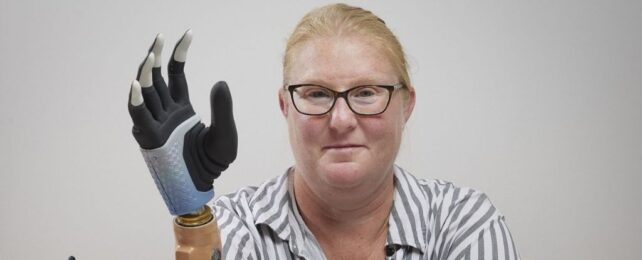A 50-year-old Swedish woman who lost her hand in a farming accident has been fitted with a cutting-edge prosthesis that has proved transformational.
The bionic hand is based on revolutionary technology that connects directly to a user's bones, muscles, and nerves – creating a human-machine interface that allows AI to translate brain signals into precise yet simple movements.
The woman who received the bionic hand, Karin (whose full name is undisclosed), now has a limited sense of touch and can move all five of her bionic fingers individually with a success rate of 95 percent.
After two decades of living without a right hand, she can now carry out 80 percent of her usual daily activities, like preparing food, picking up objects, zipping and unzipping clothes or bags, and turning door knobs or screws.
What's more, after receiving the prosthetic hand, Karin's excruciating phantom pain, which she said felt as though her hand was going through a meat grinder, decreased significantly.
"I have better control over my prosthesis, but above all, my pain has decreased," says Karin.
"Today, I need much less medication."
The international team of engineers who worked on the bionic hand recently shared Karin's success in the journal Science Robotics.
The researchers, who come from Sweden, Italy, and Australia, say it's the first time that a robotic hand with internal electrodes has shown long-term viability for amputations below the elbow.
"The fact that [Karin] has been able to use her prosthesis comfortably and effectively in daily activities for years is a promising testament to the potential life-changing capabilities of this novel technology for individuals facing limb loss," says robotics engineer, Max Ortiz Catalán, who led the research at the Bionics Institute in Melbourne, Australia and the Center for Bionics and Pain Research in Sweden (which he helped found).
When Karin was initially fitted with the prosthesis, three years ago, researchers say the technology was one of a kind. No other hand prosthesis on the market contained embedded sensors. To this day, most models have sensory electrodes on the outside, just under the 'skin' of the robot.
This convention, however, dilutes the quality and quantity of sensory signals going to and from the robotic hand, limiting its control – a problem that has plagued prosthetic technology since it first arose roughly 60 years ago.
Over the last decade, Ortiz Catalán has been working on a better solution that relies on 'osseointegration'.
Basically, that means when an implant is placed into a person's bone, the bone cells will grow tightly around it.
"This integration is so strong that we can actually attach the artificial limb directly to the skeleton," explains Ortiz Catalán in a video.
When this technique is combined with reconstructive surgery, Ortiz Catalán argues he can "truly integrate biology and electronics".
To provide an interface for Karin's prosthesis to connect to, two implants were placed in her ulna and radius bones. A muscle graft from her leg was then connected to these implants, giving the severed muscles and nerves in the stump of Karin's arm something to reattach to.
Importantly, these muscle grafts contained electrodes to amplify signals to the interface.

Because the prosthesis is directly anchored to bone, researchers say it's much more comfortable for patients to wear than conventional 'ball-and-socket' prostheses.
What's more, because the sensory electrodes are embedded inside the robotic hand instead of on the outside, direct neural stimulation is consistently and reliably perceived by the hand.
Compared to a conventional prosthesis, this new technology improved Karin's grip precision by nearly four-fold.
The prosthetic hand has been named Mia Hand, and it was developed by the Italian company, Prensilia, which specializes in robotic and biomedical devices, and funded by the European Commission.
"We at the Bionics Institute are excited by what Professor Ortiz Catalán and his team of collaborators have achieved to date, and by their ongoing development of next generation bionic limb technology – particularly in light of its potential to assist with phantom limb pain relief," says the institute's CEO, Robert Klupacs.
Ortiz Catalán is now working in Ukraine to provide expertise to amputees during the war.
The study was published in Science Robotics.
